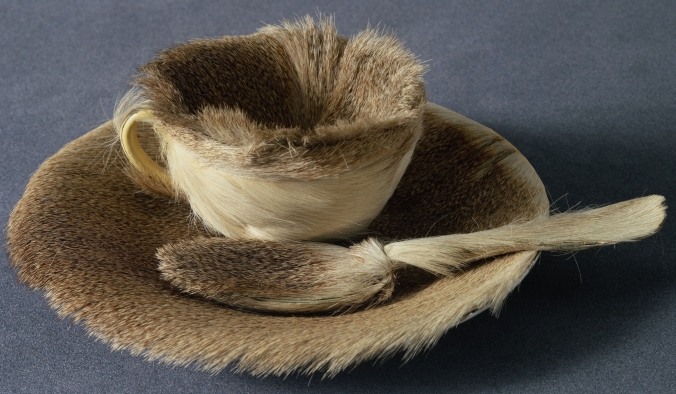
Object (Le déjeuner en fourrure), 1936, Méret Oppenheim. A Surrealist sculpture often interpreted as a visual pun referencing a hairy vagina, as the tea set is traditionally feminine.
Reader question: “I loved your post about penises, but what about vaginas? We think hairless vaginas started with porn, but I’ve definitely seen paintings in museums with hairless vaginas. What’s the deal? When did it all start?”
Aah, nudity in art, a subject dear to my heart. Vaginas and vulvas (with vulva referring specifically to the external genital region) in art have a quite different history than penises do, ranging from being symbols of fertility and life to being symbols of shame and impurity. As I wrote in my post on the Female Nude (a term I use to refer to the types of nude female subjects in paintings propagated by the French Académie royale de peinture et de sculpture in the 17th – 19th centuries) hairless vulvas have been around in art for a long time. How long? At least 2,000 – 3,000 years, and maybe even since the beginning of art as we know it.
(I’d like to preface this with saying that there have been very few large studies of vaginas and vulvas in art, especially in older art, so I’m slightly limited both by the information that is out there and the time I myself can spend researching. This summary is, as it says in the title, very brief. However, we can conclude, with certainty, that hairless vulvas have been around in art for a looong time.)
35,000 B.C.E. – 1,800 B.C.E.
Let’s start from the very beginning: when did vaginas first start getting portrayed in art? Well, arguably, an image of a hairless vulva was one of the first known artworks ever created. Created c.a. 35,000 B.C.E., this image was carved on a cave wall in Vézère Valley, France. Although it might not look much like a vulva to us (and what it represents is still up for debate), when it was discovered, it was deemed to “fall broadly within the range of ovoid forms traditionally interpreted as vulva”.
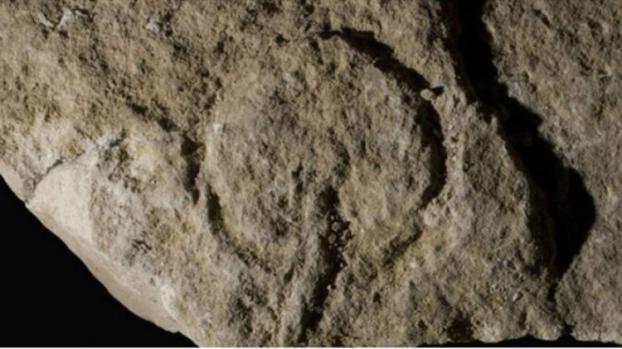
Carving, c. 35,000 B.C.E., Abri Castanet in Vézère Valley, France.
Thousands of years later, from c.a. 29,000 B.C.E. onwards, the so-called Venus figurines start popping up. These were stylized statues that mainly depicted bodies with exaggerated hips, breasts, thighs and – you guessed it – vaginas. We don’t know why they were created, but they’ve been found all over Europe, Eurasia and as far away as Siberia. Although it can be hard to tell, most of these statues seem to have hairless vulvas, sometimes even with very pronounced hairless labia.

L: The Venus of Willendorf, c. 28,000 – 25,000 B.C.E. Limestone and red ochre. Discovered in Austria. Photo: Matthias Kabel. R: The Venus of Moravany, c. 22,800 B.C.E. Mammoth tusk. Discovered in Slovakia. Photo: Martn Hlauka.
Fast-forwarding a bit in history, there’s a famous early nude statue dating around 2,500 B.C.E. from the Indus Valley Civilisation (where northwest India, Pakistan and northeast Afghanistan now lie) called the Dancing girl of Mohenjo-Daro. The presence of pubic hair here is somewhat ambiguous, especially given the stylized nature of the piece. Although she, at first glance, appears hairless, there are some lines along her pelvic region that could potentially indicate pubic hair.

Dancing girl of Mohenjo-Daro, c. 2,500 B.C.E. Bronze. Image © National Museum of India, New Delhi.
Later still, around 1,800 B.C.E., we have the Burney relief, a Mesopotamian terracotta plaque showing a nude figure with wings and talons, flanked by owls. Although the genitalia has very little detail in general, there is definitely no hint of pubic hair here.

The Burney relief, c. 1,800 – 1,750 B.C.E. Terracotta.
These are just a few, famous examples of the thousands of ancient sculptures with vaginas. Since most of the early artworks that still survive are in sculptural form, this could account for why many ancient depictions of vulvas are sans pubes: it’s very hard to render tiny hairs in a sculpture without more modern tools. Many ancient statues depicting penises follow the same pattern of hairlessness.

The Turin papyrus, c.1050 B.C.E. Papyrus. Museo Egizio in Turin, Italy.
Keep in mind that there are definitely depictions of vulvas with pubic hair from these time periods. They just don’t seem to be quite as common. In some Ancient Egyptian placques and paintings, especially from the Ramesside period (1,292 – 1,069 B.C.E.), pubic hair on female genitalia is shown through painted triangles. A famous possible example of this black painted triangle style is in the Turin Papyrus from the Ramesside period, the earliest known depiction of sex in art.

What looks like visible pubic hair in the Turin papyrus. Edited by me
It’s obviously fairly impossible for me to go through every depiction of a vagina in ancient art, let alone in every cultural artistic tradition. It’s fair to say, however, that hairless vulvas have been part of the nude figure since the beginning of art history, and that this is the case in many different cultures across the world.
600 B.C.E. – 1600 A.D.
Let’s shift our attention to a form of art that inspired pretty much all Western art that came after it, including depictions of vaginas: Ancient Greek sculptures.
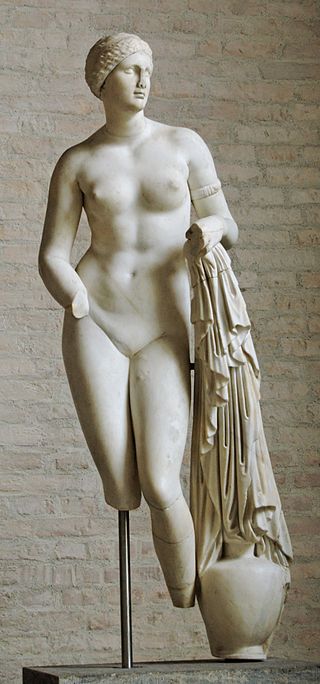
Venus Braschi, 4th century B.C.E., Praxiteles, variety of Aphrodite of Cnidos. Marble. Munich Glyptotech.
Many Ancient Greek sculptures depicted nude figures, and if these figures had vaginas, they were almost always completely hairless. These sculptures have been hugely influential as portraying a sort of “ideal” body. It should be noted that Ancient Greek sculptures were originally painted with bright colours that have since faded. It’s possible that they originally appeared with a full painted bush. However, this theory doesn’t completely hold up, considering that many statues with penises have pubic hair carved into them. Some researchers today theorise that the reason sculpted Ancient Greek vulvas did not have pubic hair was that this would have made them too sexually aggressive.
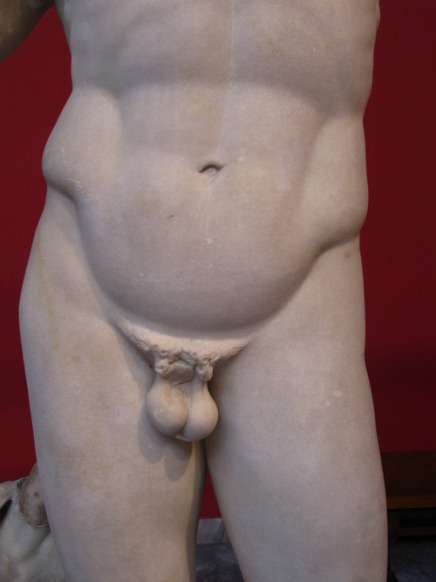
Youth binding his hair (detail of carved pubic hair), 100 B.C.E., Diadoumenos. Copy of original from c. 450 – 425 B.C.E., Polykleitos. Marble. National Archaelogical Museum, Athens. Photo © WTF Art History at http://wtfarthistory.com/post/28125718656/pubes-in-ancient-athens.
During the Renaissance, artists began looking back at the Classical era of Greek sculpture and were heavily inspired by it. Renaissance sculptures follow the same pattern as those of Ancient Greece: bodies with vaginas were always hairless, while those with penises were either hairless or had pubic hair carved into them.

Eve with a stag, c. 1540, Heinrich Aldegrever. Engraving.
Around this time surviving paintings become much more frequent, and even here vulvas were mostly hairless, although there were of course exceptions. German artist Heinrich Aldegrever’s print Eve with a stag (c.1540), for example, shows her with pubic hair. More often than not, though, nude paintings from this period were hairless. This goes for both penises and vaginas, although penises were much more likely to have pubic hair. Albrecht Dürer’s Adam and Eve (1507), for example, is comprised of two paintings of both Adam and Eve nude, and although their genitals are covered by leaves, Eve is clearly hairless while Adam has a hint of pubic hair.

Adam and Eve, 1507, Albrecht Dürer. Oil on panel. Museo del Prado, Madrid.
1600 A.D. – today

Birth of Venus, 1875, Alexandre Cabanel. Oil on canvas. An example of a Female Academic Nude.
This is where the Female Academic Nude comes in. The Renaissance tradition of the hairless female nude remained popular, and – affected by other styles and movements – grew into the types of nudes we see in 17th – 19th century Western art. You can read more about this type of nude in my post about it, and how the hairlessness was part of making the nudity acceptable. By removing markers of “realistic” bodies, including hair, the nude could be safely situated in an unreal fantasy world and was then considered suitable for public consumption.

Lovers dalliance, 1659, Mohammad Qasim. Pigments and gold on paper. (Cambridge, MA, Harvard Art Museums/Arthur M. Sackler Museum, Grace NicholsStrong, Francis H. Burr and Friends of the Fogg Art Museum Funds, 1950.130)
Middle-Eastern nude art was similarly hairless around this time, specifically in the Islamic miniature painting tradition. Mohammad Qasim, a miniaturist, painted Lovers’ dalliance in the mid-17th century, in which the vulva is clearly on display and clearly hairless. The nude became an important new genre in Persian painting during this period. Mohammed Qasim was the student of Reza Abbasi, who painted two works in the 1590s showing a semi-nude woman asleep that are considered the first true “nudes” (a.k.a. fully nude bodies that are not just literary illustrations) in Persian painting. When men are depicted in the nudes from this period they are usually fully clothed.

Tako to ama (The dream of the fisherman’s wife), 1814, Katsushika Hokusai. Woodblock print. From book Kinoe no Komatsu (Young Pines).
Funnily enough, around the same time period, female pubic hair was graphically depicted in Japanese shunga (erotica), as part of the Ukiyo-e movement from the 17th – 19th centuries in which the main medium was woodblock printing. The dream of the fisherman’s wife (1814) by Hokusai is a famous example of this, showing a carefully detailed portrayal of the main subject’s pubic hair. This is far from the only example, though, and looking at works from this era is extremely refreshing after the insidious hairlessness of almost all of art history. Not only did these images have pubic hair, but they were enjoyed by people from all classes and by no means relegated to the margins. Considering that European painters in the second half of the nineteenth century were heavily influenced by Japanese art, this frequent portrayal of pubic hair might have had something to do with the shift in Western art from hairlessness to hairy.

La maja desnuda, ca 1797 – 1800, Francisco de Goya.
The first major oil painting of a vulva with pubic hair is considered to be Fransisco Goya’s La maja desnuda, in 1797, and it caused a huge controversy. In the 1800s, Realist artists such as Gustave Courbet wanted to paint reality in an authentic way, and Courbet’s famous (and controversial) L’Origine du monde showed pubic hair front and center. Since then, pubic hair has popped up more and more often in art history, from Egon Schiele’s famous nudes to Valie Export’s performance art.
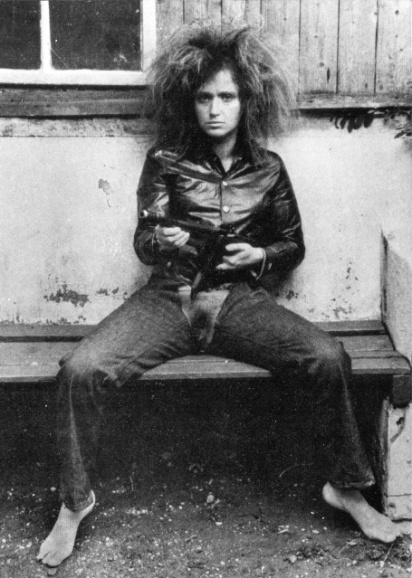
Aktionshose:Genitalpanik (Action pants: Genital panic), 1969, Valerie Export. Photograph by Peter Hassman.
As for your question, “what’s the deal?” – we don’t always know. The further we go back the harder it is to understand the cultural context. We can interpret the prevalence of hairless vaginas as a demonisation of female sexuality, as a view of pubic hair as unclean, or as a reflection of contemporary shaving practices. But whether we want it or not, modern depictions of hairless vaginas – in visual arts, photographs, movies or pornography – are not new and are probably not going to go away any time soon.
This post has been edited to include the word “vulva” as well as “vagina”, to acknowledge the limitations of “vagina” as a colloquial term referring to all parts of the genital region.
Pingback: “Why do all old statues have such small penises?” | How To Talk About Art History
I’m curious if the age of marriage and onset of puberty were different enough to warrant that being a factor as well?
LikeLike
It’s always a possibility (especially as notions of “child” and “adult” have always shifted throughout history) but given the immense range of cultures and time periods here (which all would have different marriage ages and ideas about puberty) it’s just very hard to know.
LikeLike
Something I find interesting that ties into both the discussion here of Japanese sexuality and the Female Nude post: the original Japanese title of Hokusai’s painting is closer to “Octopus and Pearl Diver”. This was considered offensive to Westerners, so the painting is universally censored to “Dream of the Fisherman’s Wife” in English — in one stroke, recasting the image as pure fantasy and transforming the career woman into a passive one identified by her husband’s profession. Notably, the text in the background has the large octopus talking, so I’m not certain the “dream” reinforcement was necessary…
LikeLiked by 6 people
That’s a really great point! It definitely relates to the importance of relegating depictions of nudity to a “fantasy” world.
LikeLike
I was wondering about that! I know that “tako” is octopus in Japanese, so I suspected the title was not translated accurately. Knowing the true title transforms the interpretation of the work completely. Thanks for this information!
LikeLike
Wow. I like this painting. It is funny how we have this need to censor so much, to hide desire.
LikeLike
It’s also possible that the Greeks depicted hairless vulvas/women because even way back then, it was common practice for women to groom and pluck their body hair. I’m thinking specifically of lines in Lysistrata referencing grooming of women’s “deltas”.
LikeLike
Definitely! There’s evidence of pubic hair grooming practices going back thousands of years. It’s interesting to think about, as well – what came first, the grooming or the art?
LikeLiked by 1 person
Reblogged this on Elsa Holland and commented:
Hairless-ness… I have to admit I never thought about nudes as being shaved or waxed…somehow there hairless state seems to add a civility to the public nakedness.
LikeLike
One more item, this time relating to ancient Egyptian customs: In general among the highest classes, body hair was considered to be unclean and impure. It was plucked away or shaved; nobles wore wigs, both male and female, and only children of the upper classes kept their hair (and not a lot of it at that– boys in particular had their heads shaved except for a sidelock that was usually braided or knotted.)
Considering problems with body lice, fleas and so forth, going hairless may have been considered a good way to stay healthy far, far back through time. If you didn’t have hair for the critters to hide and/or breed in, you were way less likely to be bitten.
One more thing: Another great source of images of historic or prehistoric female vulvas are the Celtic stone carvings known as Sheela-na-gigs, nude figures clutching their vaginas and pulling them wide open. Most (roughly 2/3 of known carvings) are in Ireland, with the remaining 1/3 in England, Scotland and Wales; they’re supposed to be good luck, but theorized meanings vary from old Pagan fertility-goddess holdovers to medieval warnings against lustful thoughts, so you can pretty much take your pick.
LikeLike
I was expecting mention of the Sheela-na-gig in this piece; it’s the first thing that comes to mind when I hear about vulvas in an art historical context (um…not that that happens often!) I took an archaeology course in Dublin many years ago and I recall discussion that their placement often over doors of churches was a reference to women as the source of “creation” (like with the Courbet painting referenced in the post) – whether you take that as celebratory or condemnatory (like the Cathars believing all flesh/material world to be sinful).
LikeLike
Muslims (both men and women) have been removing all pubic hair since the 7th century. I’m wondering if this practice was also in other cultures which would also be part of the reason for hairless vulvas.
LikeLike
I have read that Crusaders encountered local women in the Middle East that were shaved, and brought this custom home, encouraging their women to adopt this style. Because of the prevalence of public bathing at the time, it then became necessary for them to wear pubic hair wigs, called “merkins” during such activities to essentially hide the fact that they were doing this!
LikeLike
Why is this post marked NSFW but the penis post isn’t?
LikeLiked by 1 person
I simply began using the NSFW label after I wrote the penis post, and have forgotten to go back and add it. It’s been fixed now – thanks for pointing it out!
LikeLiked by 1 person
Love this blog! I’m wondering if you have seen this article http://www.theguardian.com/commentisfree/2015/apr/13/absent-female-genitals-art-repeated
It’s not just the hairlessness of the female body, it’s the lack of vulva or genital detail at all.
LikeLike
Great article, thank you!
LikeLike
Have for the most part, women not been subjugated to men? And when I read this, I am reminded of a line I read a long time ago. Actors (not porn related) who are supposed to do a nude scene tend to grow a little hair, because as they said “they don’t feel so nude and exposed”
With that in mind, could the lack of hair be as simple as domination? Portraying a woman with no growth and the vulva and all visible, for all to see be a sign to all that woman is the property of said state/men/whatever system in play? They are the property, and thus holds no secret, and all is to be seen by the man/state/religion. As the image of the whole thing nude is often associated with shame, and the best way to then remind them would be to have it in display.
LikeLike
Dürer’s 1504 copper engraving of Adam and Eve — apparently the basis for the painting — seems to have pubic hair peeking out from behind Eve’s leaf, too.
LikeLike
Something to note: The translation “The dream of the fisherman’s wife” is inaccurate. In Japanese, the name means roughly ‘fisher’s dream’. I bring this up because it demonstrates how in english, we tend to give the woman a belonging to a man, even in the title of painting where there are no men. Maybe she’s just into bestiality.
LikeLike
I really liked this blog,It is useful to everyone..Thanks for sharing!
LikeLike
One thing that pops out for me looking at the Greek statue you posted as an example of a hairless vulva…
It doesn’t look, to me, like it depicts a vulva at all.
Similar statues depicting men are quite careful at detailing the testicles and penis, but the statue of the woman has a crotch like a Barbie doll. No hint of outer labia fold, which is usually visible on a standing woman at least to some degree. It’s a blank, flat space. It almost looks like, if they were painting it, there might be knickers painted over the area (except I’d expect to see some hints of folded fabric).
I’ve read some analyses of Greek attitudes to women’s sexuality that indicate they felt it was an uncontrolled, base, animalistic thing that was dangerous for a woman’s physical and mental health, and that the more civilised influence of men was required to keep women and their wandering vaginas in check. Could the vulva as depicted in Greek art be in some way a reflection of that attitude?
LikeLike
Reblogged this on Peri Sore.
LikeLike